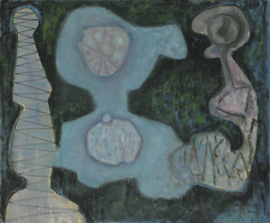
Woven No. 1, 2015,
Pigment print,
Purchase, Milton Bellin Fund, 2016.16
Today’s post comes from G.J. Bettman, class of 2017 and Art Center Student Docent.
Tanya Marcuse makes photographs through an ongoing process of gathering and framing. The artist, based in the Hudson Valley town of Red Hook, had a small exhibition of photographs in the Project Gallery at the Frances Lehman Loeb Art Center. The photographs originate from three overlapping projects within the artist’s body of work. Entitled Fallen, Woven, and Fruitless, the groups of photographs focus on the artist’s interactions with natural materials in her everyday life.
During a gallery talk on September 2nd, Marcuse traced the organic pathway from one project into the next. The earliest photographs, Fruitless, are black-and-white studies of fruit trees throughout the seasons. The artist recounted the intimate elements in the making of each photograph. She spoke of the challenges involved in working with her Gundlach Korona View Camera of choice, combined with an old-fashioned platinum printing process that requires an emulsion hand-painted on drawing paper. Through these methods, Marcuse’s photographs call for a distinct kind of attention in response to the fruit tree depicted–one interacts with the tree as a subject in a portrait, not as an object in a landscape. From her continued observation of trees as individuals to the choice of unusual paper and camera, Marcuse photographs these trees as an act of devotion. Her reverent images work against the hierarchy between humans, plants and animals that has been codified and reproduced throughout the history of art.
After Fruitless, the artist began working on Fallen, which engages with decaying fruit arrayed on the ground in the orchards. She collects the fruit that she finds interesting and brings it home in order to work with it under different lighting conditions. Mingling the space of her home with the materiality of the natural world, Marcuse makes compositions in her backyard, arranging varied states of life and matter on the ground and commemorating these constructions in photographs. Marcuse places the snakeskins her pet snake sheds alongside the physical bodies of dead snakes she collects while walking in the woods. Placed in dialogue with these reminders of mortality, the partially-transparent skins evoke cycles of growth, decay, transformation, and time.
Most generally, the art of photography arises from the collection of light and dark information using the lens of a camera. Photographs memorialize subjects, objects, and experiences together in compositions. Marcuse gathers objects over time and then frames them in a moment. The threads of time in her everyday life weave together with the threads of each object in the photographs to create a photographic tapestry in the timespace of art. Referencing figures of eternity such as Leonardo and Hieronymus Bosch, whose disciples and contemporaries are represented elsewhere on the walls of the Art Center, Marcuse’s photographs aid us in meditating on the constant presence of death within life.




